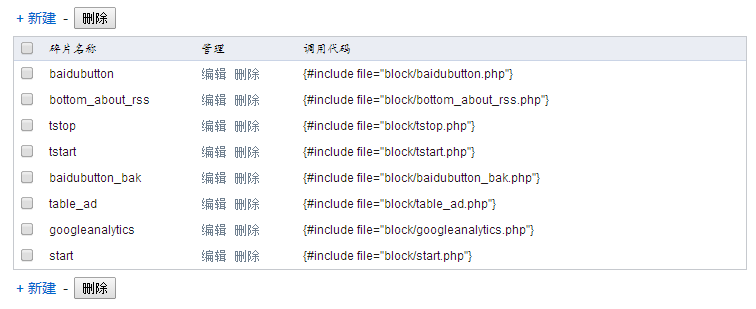K9模板标签本身已经支持引用标签。
碎片应用也有类似的标签,两者都是使用{#include file=""}进行引入文件。
K9引用标签
{#include file='include/top.php'}
- file是文件路径,其值为相对于当前被应用的模板目录路径。
- 被引用的文件也会被正常解析标签。
引用标签同时可以用 require 别名,效果同上:
{#require file='include/top.php'}
碎片应用标签
碎片应用作为模板制作的一项辅助功能,用于管理网站模板重用的代码。
这样做的好处十分明显,一方面减少重复编码的工作量,另一方面便于批量修改重用部分的代码。
碎片的内容支持纯HTML,纯PHP,也支持K9模板标签代码。
{#include file="block/bottom.php"}
碎片名称必须为以下字符构成:
- 小写英文
- 数字
- 下划线
引用标签和碎片标签的区别
虽然两者都是使用{#include file=""}进行引入文件。
但碎片应用的标签采用双引号包含文件,并且支持在线编辑和增加备注,如下图所示:

引用标签应用举例
Example1是一个标准的K9模板框架:
Example1.php
<?php !defined('INC') && exit('Load failure!'); ?> <!-- HTML模板代码开始 --> <html> <head> <title> <!-- 页面标题 --> </title> </head> <body> <div id="top"> <!-- 这里可以输出头部信息,如Logo等 --> </div> <div id="main"> <!-- 主体部分 --> </div> <div id="bottom"> <!-- 这里可以输出页面底部信息 --> </div> </body> </html> <!-- HTMl模板代码结束 -->
我们在该模板的目录新建文件夹命名为:include。
再在include文件夹新建两个php文件:
top.php
<?php !defined('INC') && exit('Load failure!'); ?> <div id="top"> <!-- 这里可以输出头部信息,如Logo等 --> </div>
bottom.php
<?php !defined('INC') && exit('Load failure!'); ?> <div id="bottom"> <!-- 这里可以输出页面底部信息 --> </div>
修改Example1.php的代码,称为Example2.php。
Example2.php
<?php !defined('INC') && exit('Load failure!'); ?> <!-- HTML模板代码开始 --> <html> <head> <title> <!-- 页面标题 --> </title> </head> <body> {#include file='include/top.php'} <div id="main"> <!-- 主体部分 --> </div> {#include file='include/bottom.php'} </body> </html> <!-- HTMl模板代码结束 -->
Example2.php使用引用标签,实现和Example1.php完全一样的代码。
其中,{#include file='include/top.php'}可以使用以下代替:
{#require file='include/top.php'}{#include file="block/top.php"}
有兴趣的同学可以自行实践。
转载请注明出处:唯众网络

